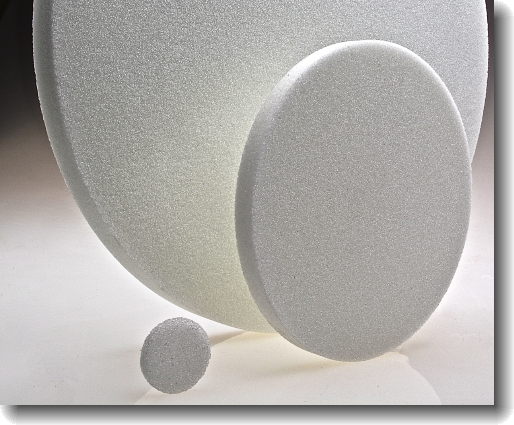Frit Info
Fritted glass is manufactured from particles of glass which are fused, or sintered, into a solid, but porous glass body, typically a disc, which can then be sealed into glass tubing as a filter made entirely of glass.
In our discussions with customers and vendors regarding fritted glass for filtration and other applications, we have found a wide range of uses. There are a variety of porosity standards. We have concatenated information here to help you make intelligent choices about porous glass, and to make it easier for us to serve you.
Frit porosities are defined in three different systems, as shown here. The choice of porosity for your application will be determined by different factors: the size of filtered particles, the flow necessary through the frit, the size of packing in chromatography columns, or resin beads for peptide and small molecule synthesis. See our notes about mesh designations.
Fritted discs are made by heating glass particles or fibers at a high enough temperature that they fuse together sufficiently that they become a relatively strong object. In our case, the glass is borosilicate glass, and is the same as the standard material for laboratory apparatus, i.e. Pyrex 7740, Kimax KG-33, or Schott Duran. The Kimble and Corning, and Robu frits are made from particulate glass, while the Ace frits are made from short pieces of fiber, and are alleged to be stronger. Once formed, the fritted disc can be sealed into tubing as part of a variety of apparatus, for filtering, supporting column packings or resin beads, etc.

Porosities of sintered glass filters are determined dynamically: air is forced through a frit just immersed in water until a bubble goes through. The pressure required correlates with the pore size. According to theory: pore diameter (in microns) = 30 * surface tension (in dynes/cm) / pressure (in mm HG). This should correlate with the average pore size of the whole frit.
Pore volumes and surface areas vary with the porosity. A graph of flow rates for air and water for various porosities (in the European ISO 4793 system) is available as a pdf. There is also a pdf regarding pore properties.
The realities of fusing a frit into a tube provide endless possibilities of variation. Small diameter frits and the finer porosities in particular can be problematic. Your mileage may vary.


